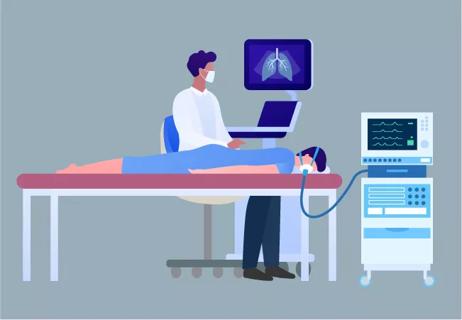Pearls to reduce the strain of RSV, COVID-19 and influenza infections

Note: This article is a slightly abridged version of a review first published in the Cleveland Clinic Journal of Medicine (2025;92(2):95-102). A full version of the open-access article with all tables and figures is available here.
Advertisement
Cleveland Clinic is a non-profit academic medical center. Advertising on our site helps support our mission. We do not endorse non-Cleveland Clinic products or services. Policy
Written by Pooja Cerrato, PharmD, BCPS, and Steven Mawhorter, MD, DTM&H
Helping our patients stay healthy during respiratory virus season requires a comprehensive approach, with preventive measures, vaccination, efficient diagnostic tests, and targeted medications — and we need to communicate clearly with our patients what we want to do, and why.
Here, we review the burden, prevention, diagnosis, and treatment of three important respiratory viral illnesses: respiratory syncytial virus (RSV) infection, COVID-19 and influenza. Acknowledging the pressure that the respiratory virus season places on frontline clinicians and their practices, we offer an analogy-driven narrative for patient communication.
When talking to patients about ways to avoid respiratory infections, we find it useful to use the analogy of avoiding motor-vehicle accidents:
First, avoid exposure to infections as much as possible. Use handwashing and mask-wearing as appropriate, and limit crowd contact. This is analogous to defensive driving.
Second, vaccinate against infectious diseases, especially when it is difficult to limit exposure. This is analogous to wearing seat belts.
Third, use symptom-triggered medication if a patient is allergic to vaccines, refuses to be vaccinated, or has a breakthrough infection. Analogy: air bags.
Influenza, COVID-19 and RSV infections can be compared to a car running through a stop sign—an event beyond our control. While seat belts (vaccines) and air bags (medications) cannot prevent accidents (illnesses), having them in place significantly reduces the severity of the outcomes. Vaccines prime our immune system for a swift and effective response. Using all three elements together—avoidance, vaccination and treatment—ensures an optimal outcome, embracing a “both/and” approach rather than an “either/or” mindset. This analogy helps some vaccine-hesitant patients to agree to vaccination by explaining its role in understandable terms.
Advertisement
The early COVID-19 lockdown and the widespread adoption of physical distancing, mask-wearing and enhanced hand hygiene helped limit the spread of not only COVID but other respiratory viruses as well. For example, only 1,899 (0.2%) of more than 1 million clinical samples tested positive for influenza A or B during the 2020 to 2021 period.1
Vaccines also play a crucial role. Shattock et al2 estimate that since 1974, childhood vaccination has prevented 150 million deaths, including 140 million among children under five and 100 million among children younger than one year. On average, for every life saved, 66 years of full health were gained, totaling approximately 10.2 billion years of health. The investigators estimate that vaccination contributed to 40% of the observed decline in global infant mortality and 52% in Africa. Thanks to vaccination, in 2024, a child under 10 years old is 40% more likely to survive to their next birthday than they would be if vaccines had never been invented. This increased survival benefit extends into late adulthood as well.
The topic of vaccine hesitancy and how to deal with it has been recently covered in two excellent articles in this journal.3,4
Respiratory viruses cause significant morbidity and death. The Centers for Disease Control and Prevention estimates that between 2010 and 2023, influenza caused 9.3 to 41 million illnesses, 100,000 to 710,000 hospitalizations and 4,900 to 51,000 deaths each year.5
They also impose a significant economic burden on individuals and society. Molinari et al6 estimate that seasonal influenza costs the U.S. economy nearly $90 billion each year in the form of medical expenses, lost workdays due to illness and deaths. They suggest that interventions targeting the elderly could offer the greatest economic benefit, as this group bears 64% of the total economic burden, including 36,000 deaths annually.
Advertisement
Vaccination reduces illness severity and saves lives. Here are the current formulations and their indications.
The 2024–2025 seasonal influenza vaccine in the United States is trivalent, containing hemagglutinin from three strains7:
In past years, the U.S. seasonal influenza vaccine was quadrivalent. However, this year, the vaccine no longer contains the B/Yamagata strain, which has not been detected globally since March 2020.
Three types of influenza vaccines are available: inactivated (which are egg-based), recombinant (which are not egg-based), and a live attenuated formulation (which, unlike the others, is inhaled rather than injected).7
Influenza vaccine is recommended for all persons age 6 months and older, but certain groups may be at higher risk of medical complications attributable to severe influenza and therefore should be prioritized for vaccination:7
Advertisement
Ideally, influenza vaccine should be offered in September or October, according to the Advisory Committee on Immunization Practices (ACIP). However, vaccination efforts should continue as long as the influenza virus is circulating.
All persons should receive a vaccine that is appropriate for their age. Adults aged 65 and older should receive an enhanced influenza vaccine (ie, either a high-dose formulation of inactivated or recombinant influenza vaccine, or adjuvanted influenza vaccine), if these are available. Live attenuated influenza vaccine is not recommended in pregnancy or for immunocompromised persons.7
Persons with egg allergies may receive egg-based vaccines and are not at increased risk for adverse events in doing so.8 In most cases, no additional safety measures are needed when giving egg-based influenza vaccines to egg-allergic individuals.
There are two types of COVID-19 vaccines: messenger RNA (mRNA)–based and protein subunit (spike)–based. The U.S. Food and Drug Administration has approved the 2024–2025 COVID-19 mRNA vaccines by Moderna (Spikevax) and Pfizer-BioNTech (Comirnaty) for persons 12 years and older. These vaccines are also approved for children aged 6 months to 11 years under emergency use authorization. The 2024–2025 COVID-19 adjuvanted protein subunit vaccine by Novavax (Nuvaxovid, Covovax) is also approved under emergency use authorization for persons 12 years and older.
The approved vaccines are monovalent and protect against the currently circulating JN.1 variant of COVID-19.9,10
Advertisement
The ACIP recommends a US Food and Drug Administration–approved 2024–2025 COVID-19 vaccine for all persons aged six months and older.
Although hospitalization and death rates are much lower now than at the height of the pandemic, COVID-19 infection remains an ongoing public health concern. During the 2023–2024 season, by age group, the COVID-19–associated hospitalization rate was highest in those age 75 and older, in whom it peaked at 207 cases per 100,000 people in December 2023.11 However, in the same month, hospitalization rates were also high in adults 65 through 74 years old (63 cases per 100,000 people) and infants younger than six months (75 cases per 100,000 people).11 COVID-19–associated death rates were also highest in those 75 and older (peak of 46 deaths per 100,000 people in January 2024).11
Data from the 2023–2024 bivalent COVID-19 vaccine were reviewed in the approval process for the updated vaccines.12 Vaccine effectiveness, a comparison of the frequency of disease in vaccinated and unvaccinated people in real-world conditions, was evaluated for various end points in adults and adolescents: medically attended emergency department and urgent care visits due to COVID-19 (pooled vaccine effectiveness 43%), hospitalization due to COVID-19 (pooled vaccine effectiveness 44%) and prevention of death due to COVID-19 (pooled vaccine effectiveness 23%).
A vaccine effectiveness of 23% means that vaccination reduces the risk of death by 23%. This might seem like a modest reduction, but remember that the most vulnerable individuals have already been affected by the disease, and over time, population immunity, due to vaccination and previous infections, continues to increase. In infants and children, the vaccine effectiveness in terms of medically attended emergency department and urgent care visits was 80%.12
Regarding safety, investigations are ongoing regarding possible associations between Guillain-Barré syndrome and Pfizer-BioNTech COVID-19 vaccine among people 65 years and older, ischemic stroke and Moderna COVID-19 vaccine in the same age group and ischemic stroke and the Pfizer-BioNTech vaccine among adults aged 50 to 64 years. However, at this time, no direct link to vaccination has been established.12
In August 2021, 69% of adults reported being up to date on COVID-19 vaccines. This had dropped to 28% in February 2024.12 The 2024–2025 COVID-19 vaccines can provide protection against currently circulating variants and reduce rates of COVID-19–associated hospitalization and death.12
Three RSV vaccines are available from GSK, Moderna and Pfizer. The GSK and Pfizer RSV vaccines are protein subunit products, while the Moderna RSV vaccine is an unadjuvanted mRNA-based product.13–16 Overall, the Pfizer RSV vaccine demonstrated strong efficacy that was maintained over two seasons, and it was well tolerated by patients.15
In June 2024, the ACIP13 revised its recommendation on RSV vaccination. Previously, it said that adults aged 60 years and older may receive a single dose of RSV vaccine; now, it says that all adults aged 75 years and older should receive it, as should those age 60 through 74 years who are at higher risk for severe RSV disease, including, for example, those with any of the following:
Pregnant women should also be vaccinated, which is beneficial both for their own protection and for passing on immunity to their babies. Only the Pfizer RSV vaccine is approved to be given in pregnancy.14,15
It can be hard to tell which virus a patient has solely on the basis of signs and symptoms. Multiple respiratory viruses are often circulating simultaneously and producing similar clinical signs. Perhaps the distinction did not matter so much in the past, when we could just say “the patient has a virus.” But now we have specific drugs for some viruses, and moreover, the drugs need to be started as soon as possible after the onset of symptoms. Thus, the need for laboratory tests to identify the pathogen — and quickly! Delays in obtaining precise and timely results can compromise patient care.17
Triple reverse-transcription polymerase chain reaction (RT-PCR) tests can simultaneously detect severe acute respiratory syndrome coronavirus 2 (SARS-CoV-2, which causes COVID-19), influenza and RSV from a nasopharyngeal swab, and their use can accelerate the process from sampling to diagnosis to treatment. As COVID-19 and influenza have specific antiviral treatments, testing for them conserves resources, especially when timely treatment prevents severe illness or hospitalization. Multiplex assays such as these also have the potential to enhance and expand surveillance systems, leveraging the capabilities developed during the COVID-19 pandemic to improve epidemic and pandemic preparedness, prevention and response.17
Using RT-PCR rather than rapid antigen tests may seem counterintuitive, since the latter are, well, rapid, and patients can do them themselves in the comfort and privacy of their own homes. However, PCR is more sensitive than rapid antigen testing and thus gives fewer false-negative results. Also, testing for three viruses at once is an advantage, and if we get organized and set up our practices to obtain and process RT-PCR tests quickly, the time and convenience factors can be overcome.
In a study in 263 children, the sensitivity of a triple RT-PCR test was 88.9% (95% confidence interval [CI] 51.8%–99.7%) for SARS-CoV-2, 91.6% (95% CI 84.1%–96.3%) for influenza and 79.1% (95% CI 64.0%–90.0%) for RSV.18 Specificity was 100% for each virus.
We encourage both patients and clinicians to prioritize early testing, ideally using nasopharyngeal swab PCR platforms rather than home antigen tests. In a study in Florida, state organizations provided PCR testing for individuals who tested positive on the home antigen tests, showed symptoms, or requested PCR testing.19 Of 18,457 individuals tested, 3,153 (17.1%) were PCR-positive. The positive percent agreement of the antigen test compared with PCR was 49.2% overall and 51.9% for people with symptoms. The study found that the antigen test’s performance was lower than previously reported. Without amplification and with the potential for incomplete sample collection when conducted at home rather than by healthcare professionals, real-world antigen testing is expected to be less accurate than PCR testing. Additionally, a negative result from a home antigen test—especially early in the course of illness — should be repeated in two to three days, when viral load is typically higher, often leading to a positive result at that time.19
Starting antiviral medications early is important—within two days for oseltamivir and five days for nirmatrelvir-ritonavir, molnupiravir and remdesivir for patients with intact immune systems—emphasizing the importance of prompt testing. Patients on steroids, other immunosuppressant medications, or periodic infusions (e.g., adalimumab, ocrelizumab) should start oseltamivir with a confirmed influenza diagnosis regardless of duration of symptoms. 20,21,22
References
Advertisement

Despite benefits, vaccination rates remain low for high-risk population

No effect on symptom severity or disability, and low prevalence of long COVID

Dynamic modeling improves the accuracy of outcome predictions for ICU patients

A review of IDSA and NIH guidelines

Chemicals in e-cigarettes weaken the epithelial barrier in airways

Study sheds light on how clinicians addressed their patients’ pain and insomnia during the pandemic

While logistical questions remain about RPM, its benefits for both patients and caregivers are abundantly clear

Cleveland Clinic pulmonologists share a framework for how to implement effective clinical protocols to standardize evaluation and management of complex acute respiratory distress syndrome